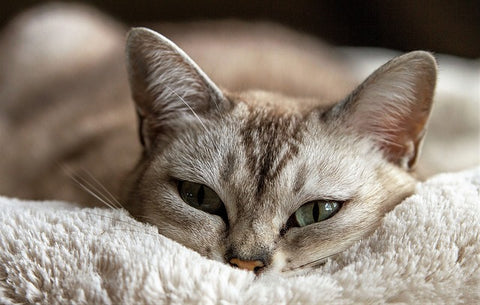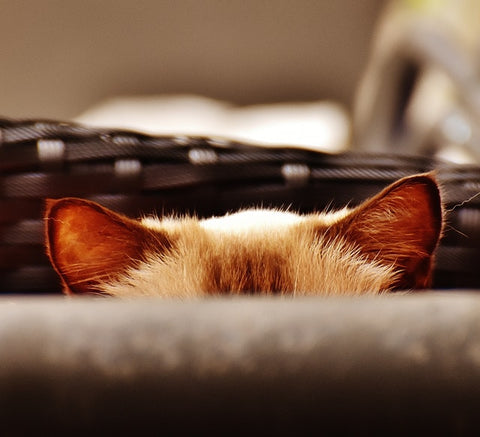What are your cat's ears telling you?
Sometimes I think it would be nice if our cats could just talk to us. Of course, most of my cats would probably just repeat the same six words all day long: “Can I have a treat now?”
But then I remembered that cats do talk to us: with body language. We just have to learn to speak their language.
A cat’s ears are surprisingly expressive, if you know what you’re looking at. Learn to read a cat’s ears and you’ll get some insight into what’s on his mind. And that’s almost as good as a talking cat. Some days, maybe it’s better.
Cats ears are surprisingly mobile

Cats might not be as concerned with verbal conversation as their human guardians, but their ears were designed to be very sound-sensitive.
Cats have 32 muscles in their ears,[1] compared to our six. Why so many muscles? All those muscles give a cat not only an extreme range of motion in their ears – cats can swivel them 180° – but also incredible dexterity. Imagine the ear gymnastics you could perform with another 26 muscles surrounding each of your ears!
Cats’ need their magical ears for everything that cats do: catch prey, avoid predators, and communicate with other.
Cats ears are super-sensitive

Cats do have amazing hearing. While humans and cats have a similar range of hearing on the low end of the scale, cats can hear much higher pitched sounds. Cats can hear sounds up to 64 kHz, which is 1.6 octaves higher than our ears can hear, and an octave higher than dogs’ ears.[2]
But the ear muscles are what put that amazing ability to its best use.
The visible part of the ear that we colloquially refer to as a cat’s “ears” are actually called pinnae, and cats can move each of their pinna backward, forward, and sideways, independently of the other ear, thanks to those 32 muscles. The pinnae are cone-shaped for a reason: they funnel sound into the ear and amplify that sound.

The mobility of the ear is what allows a cat to finely pinpoint the source of any sound. A cat can identify the precise location of a sound source to within inches from three feet away (we’re talking the precise location of a skittering mouse, not a drum set) within a fraction of a second.[3]
Try it yourself: have a friend stand 10 feet away, holding retractable ballpoint pens – one in each outstretched hand – a few inches apart. Close your eyes and see if you can tell which of your friend’s hands has clicked a pen. How far apart do your friend’s hands have to be for you to tell? How close does your friend have be standing for you to know which hand did the clicking?
Cats use their ears to “talk” to other cats
Cats generally communicate with each other from a distance.

Well, that’s not entirely true. Cats are social with other cats in their family group. They will gladly get up close and personal with cats with whom they have already bonded. Friendly cats may communicate with touch, such allorubbing (two cats rubbing bodies against each other) and allogrooming (two cats grooming each other).[4]
But with cats outside the family group, cats will communicate from a distance. Cats are conflict avoidant, and the way that they avoid conflict is by not meeting face to face with stranger cats.
To convey a message to other cats without getting too close, cats employ other communication strategies, including scent communication and body language.
And body language is where 32 muscles in the ear come in very handy.
(If you want to learn more about scent communication, read, “Why do cats spray or mark with urine?” or "Why does my cat head butt me?" or "Why does my cat stick his butt in my face?')
(If you want to learn more about other kinds of cat body language, read, “Why does my cat swish or wag her tail?” and also, “Why do cats have whiskers?”)
What are my cat’s ears saying?

Cats ears say a lot about how a cat is feeling. To other cats who are very experienced in interpreting body language, the message is loud and clear. To us thick-headed humans, ear position seems an awfully subtle way to get your point across.
But it’s worth learning what a cat’s ears are saying and it’s not that hard to do once you become familiar with the “code.” Understanding what another living being is feeling at any given moment is a worthwhile endeavor, especially when that other being is someone you love and share a home with. A deeper understanding of your cat can only improve your bond with your cat.

Ears softly pointing forward
Your cat is likely feeling content. Your cat’s ears may be slightly tilted back, or turned slightly to the side.[5] There is a softness to the position of the ears that differentiates it from the erect forward-facing ears described next. This is the perfect time to take advantage of a friendly, positive mood. See if your cat wants to be picked up and cuddled. (Read, “How to pet a cat.”)
Here is what a relaxed cat's ears look like:

Ears very erect and forward facing or swiveling
Your cat is very alert and curious about something. Is there a bird at the feeder, or a squirrel in the yard? The swiveling ears might be trying to pick up a sound, like satellite receiver. This might be a good time to engage your cat in play with her favorite toy. (Make your own after reading this blog post, “DIY toilet-paper roll toys for cats.”) But this is definitely not a time for snuggling.
Here's a video that shows some very swivel-y ears:

Ears turned backward or sideways
Your cat is likely feeling annoyed or overstimulated, and possibly anxious or frightened. The ears may twitch or flutter. It might be time to stop petting him. He's probably also had enough of that fishing-rod toy you're dangling in front of his face.[6]
Here's a cat with "airplane" ears, as backward or sideways ears are sometimes called:

Ears flattened against the head
Your cat is likely feeling defensive or afraid. Is the dog bothering her? Is there a kitty bully in your house? Note that in cats, fear can quickly transition into aggression. This is not a time to pick up your cat – unless you enjoy being scratched.[7]
This young cat puts his ears back around 18 seconds into the video:
My favorite ear fact

OK – this has nothing to do with ear position, but it does have something to do with cat ears. This is just a bonus for reading this far into this post.
Have you ever noticed the little slit on the side of your cats’ ears? It’s called “Henry’s Pocket.” The science-y name for it is “cutaneous marginal pouch.”[8]
Cats aren’t the only creatures to have a Henry’s Pocket. Some dogs, weasels, and bats have them, too.
No one knows why some animals have Henry’s Pockets. Some speculate that it helps them hear higher pitched sounds when hunting. Whatever the current function of these cute little ear flaps, we can assume that it was especially useful to a common ancestor of all the creatures who have them. Evolution is efficient, and it’s not likely that such a trait was passed on without purpose.
The pockets, unfortunately, make great hideouts for ticks and fleas. Make sure your vet checks the Henry’s Pockets on your cat at every visit.
Read about cats with unusual ears in these posts:
Love Pinterest? Here's a Pinterest-friendly pin for your boards!

Dawn LaFontaine
Dawn LaFontaine is a lifelong animal lover who always seems to have a little pet hair in her keyboard. Her blog, Kitty Contemplations, helps cat guardians better understand and care for the special beings they share their lives and homes with. Her cat-products business, Cat in the Box, sells beautiful, well-made, and award-winning products that she designed to meet the biological needs of cats.
_______________
FOOTNOTES
[1] “10 Things You Didn't Know about Cats and Dogs.” Vetsource, 26 Sept. 2019, vetsource.com/news/10-things-you-didnt-know-about-cats-and-dogs/.
[2] “Cat Senses.” Wikipedia, Wikimedia Foundation, 10 Aug. 2021, en.wikipedia.org/wiki/Cat_senses.
[3] “The Five Senses According to Cats: Hearing.” Cats on Broadway Veterinary Hospital, 19 Feb. 2019, www.catsonbroadwayhospital.com/the-five-senses-according-to-cats-hearing/.
[4] Care, International Cat. “International Cat Care.” International Cat Care, 6 Oct. 2019, icatcare.org/advice/cat-communication/.
[5] Bingham, Andee. “5 Ear Signals Every Cat Owner Should Know.” IHeartCats.com, 27 Aug. 2018, iheartcats.com/5-ear-signals-every-cat-owner-should-know/.
[6] “The Cat's Meow.” The Humane Society of the United States, www.humanesociety.org/resources/cats-meow.
[7] “Cat Talk: A Guide to Cat Body Language.” Petfinder, 9 Dec. 2016, www.petfinder.com/cats/bringing-a-cat-home/how-to-read-cats-body-language/.
[8] “Henry's Pocket.” Wikipedia, Wikimedia Foundation, 5 July 2021, en.wikipedia.org/wiki/Henry%27s_pocket.



5 comments
Dear thecatisinthebox.com admin, Thanks for the well-organized and comprehensive post!
Umm- You are right to read your cat’s ears in context! Cats don’t know “the code.” They can turn an ear for any number of reasons and observant cat guardians will take all that information in when deciding what a turned ear really means.
Susanna – Thanks for your kind comments! You are spot-on with your assessment of swishing tails and preening. For anyone else reading these comments, I’ve got a “swishing tail” blog post, too: https://thecatisinthebox.com/blogs/kitty-contemplations/why-does-my-cat-swish-or-wag-her-tail